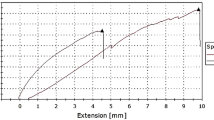Abstract
Unidirectional composites consisting of a borosilicate glass (Corning 7740) matrix reinforced with Nicalon (silicon carbide) fibres were fabricated and tested in monotonic tension at temperatures ranging from room temperature to 650 °C. The ultimate tensile strength showed little dependence on temperature up to about 425 °C and failed by longitudinal splitting. There was a significant increase in strength at 540 °C and a slight decrease in strength when tested above this temperature, and the failure involved extensive fibre pull-out. The elastic modulus (stiffness) was found to decrease progressively with increasing temperature. The matrix consists of borosilicate glass within the plies and very fine grains of alpha (low) cristobalite in the inter-ply regions. The behaviour of the composite as a whole was found to be dependent upon the behaviour of the matrix at the temperature of testing.
Similar content being viewed by others
Reference
K. M. Prewo, J. J. Brennan andG. K. Layden,Ceram. Bull. 65 (1986) 305.
K. M. Prewo,ibid. 68 (1989) 395.
O. Sbaizero andA. G. Evans,J. Amer. Ceram. Soc. 69 (1986) 481.
T. Mah, M. G. Mendiratta, A. P. Katz, R. Rah andK. S. Mazdiyasni,ibid. 68 (1985) C248.
K. M. Prewo, B. Johnson andS. Starrett,J. Mater. Sci. 24 (1989) 1373.
K. M. Prewo andJ. J. Brennan,ibid. 15 (1980) 463.
A. Briggs andR. W. Davidge,Mater. Sci. Engng A109 (1989) 363.
D. C. Boyd andD. A. Thompson, “Glass Ceramics”, Kirk-Othmer Encyclopedia of Chemical Technology, Vol. 11, 3rd Edn (Wiley, New York, 1980) p. 809.
“Properties of Coming's Glass and Glass Ceramic Families”, Product information from Corning Glass Works, Corning, NY 14830.
R. H. Doremus andA. M. Turkalo,Science 164 (1969) 418.
G. R. Srinivasan, I. Tweer, P. B. Macedo, A. Sarkar andW. Haller,J. Non-Cryst. Solids 6 (1971) 221.
W. Haller, D. H. Blackburn, F. E. Flagstaff, andR. J. Charles,J. Amer. Ceram. Soc. 53 (1970) 34.
V. S. R. Murty andM. H. Lewis,J. Mater. Sci. Lett. 8 (1989) 571.
S. M. Cox andP. L. Kirby,Nature 159 (1947) 162.
“Information about NICALONTM Ceramic Fiber”, Product Information from Dow Corning Corporation, Customer Service Department, Midland, MI 48686.
Author information
Authors and Affiliations
Rights and permissions
About this article
Cite this article
Ramakrishnan, V., Jayaraman, N. Tensile behaviour of borosilicate glass matrix-Nicalon (silicon carbide) fibre composites. J Mater Sci 27, 2423–2428 (1992). https://doi.org/10.1007/BF01105053
Received:
Accepted:
Issue Date:
DOI: https://doi.org/10.1007/BF01105053



